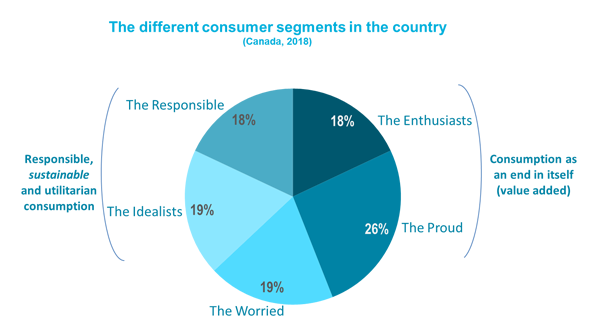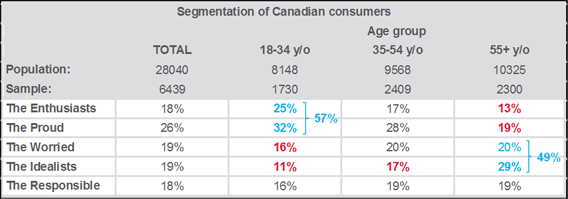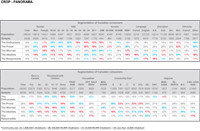Similar to the divisions in society, current consumer trends are highly divisive. Gone are the days when we could identify consumers solely by income or age. Value-added is no longer the sole prerogative of the wealthy nor innovation the sole domain of the young (despite the grain of truth there).
To truly understand the choices consumers are making today, you need to understand their personal values. These guide their choice of products, services and brands and inform their decisions. Of course, some correlations with demographic and economic characteristics (age, sex, education, income, etc.) still pertain, but this is because these traits are correlated, to some extent, with people's values. But it is values, above all, that influence consumer choice. In any case, this is what our work has concluded.
Having observed this phenomenon for many years and measuring the rise of very distinct trends, we have synthesized our work by grouping (segmenting) Canadian consumers into large families (segments), each with very different motivations.
Three major trends have been on the rise for the last ten years or so (since the last recession) and point to consumer needs and expectations:
- A gratification frenzy through consumption (regardless of the category, there is an imperative to buy, shopping is an irrepressible need, a unique pleasure!)
- A sensitivity to the ecological and social issues of our times (consuming in a sustainable, environmentally and socially responsible way)
- Pronounced financial concern, leading to a focus on price as the main (if not the sole) purchasing criterion
Given the complexity and social turbulence we have experienced for several years, a need for escape has become increasingly important to people. While the entertainment industry in all its forms has benefited, consumption itself has become a unique source of gratification. Consuming has become a priority value for people-one life's greatest pleasures! (See my article on this specific topic.)
At the same time, some consumers are uneasy about the socio-economic environment. In response, they are very cautious and prioritize price when shopping. For them, pleasure and escape are not motivating factors. They are buying "commodities" out of necessity while adhering strictly to their budgets.
Finally, over the years another cohort of consumers has become very sensitized to social and ecological issues. In response to being constantly bombarded with apocalyptic scenarios for the future of the planet, society, and even life on earth, these consumers increasingly feel that they must take up the challenge and contribute to solutions to these issues, specifically through their choices in the marketplace.
Five segments of consumers, five very different needs
When we synthetize these trends and everything associated with them, we get five large families of consumers in Canada with virtually no regional variation:
The Enthusiasts (18%):
For them, consumption is unquestionably an end in itself. They consume for the sheer pleasure of it, for gratification, to escape, to give meaning to their lives, for the pride of flaunting the most prestigious and innovative products on the market, to express their uniqueness, as a source of inspiration, as a way to feel empowered.
The main value proposition to convince them to buy: innovation.
The Proud (26%):
Here, consumption is all about social status. It is experienced and expressed in a very traditional way: "Keeping up with the Joneses." These individuals tend to be very conservative and define their identity by what they buy, because they buy to show it off to others in a social context.
The main value proposition to convince them to buy: looking good.
The Worried (19%):
An apocalyptic and Darwinist view of life today (the world is a jungle). There are so many threats and risks that extreme caution is called for. Their attitude to the marketplace is primarily determined by this cautious approach. They buy only what they know is a sure thing and at the lowest price.
The main value proposition to convince them to buy: being the cheapest around.
The Idealists (19%):
Here, too, an apocalyptic view of the world informs the choices of these consumers. Ecological alarmism is at the heart of their worldview. But for these consumers, the threats provide the necessary impetus to want to change the world. They dream of social equality, ecological lifestyle choices, social engagement and solidarity, and sincerely believe that where there's a will, there's a way. For these individuals, the apocalypse is a project that guides their choices in life.
The main value proposition to convince them to buy: change the world, one small step at a time!
The Responsible (18%):
Social and ecological responsibility is at the heart of their motivations, but here it is their connection to others that causes them to act-the appeal of helping others, to be a part of a human movement. Our world does not offer the same opportunities to everyone. Species are disappearing. Climate change, wars, the misery that is forcing populations out of their homelands. These consumers want to make a difference to these issues on a human level. They hope that companies and institutions will call on them to take part in initiatives that tackle some of these social or ecological problems.
The main value proposition to convince them to buy: let's get involved together.

However, age is strongly associated with these consumer segments. The majority (57%) of The Enthusiasts and The Proud segments are under 35, 49% of The Worried and The Idealists are 55 or older, whereas The Responsible have a more or less even age and generational distribution. These results are also consistent with our usual findings for consumer trends: young people tend to be driven by a pursuit of pleasure and social recognition through consumption, while a sense of social responsibility tends to grows as one ages.

Opposing social forces driving consumer markets
In this era of ecological threats, when our very way of life is being called in to question (if we want to save our species), having a plurality of consumers who are deeply motivated by a need to "buy" augurs well for the economy, and for the brands and retailers able to reach them in relevant ways. This trend, however, does not bode well for the planet.
On the other hand, The Idealists and The Responsible tend to restrict themselves to more frugal consumption styles, which could be very good for the planet but less so for the economy.
A potentially "sustainable" future might lie with consumers such as The Enthusiasts, who are the youngest in our segmentation. They are certainly very diligent consumers, contributing more than their share to the economy, while still being very sensitive to the ecological and social issues of the times. They are looking for ecologically and socially responsible products - thus creating a demand for them combined with strong pressure on brands, manufacturers and retailers.
In the meantime, those who are able to identify these different segments in their customer databases and reach them with the appropriate messages and products will undoubtedly succeed!
